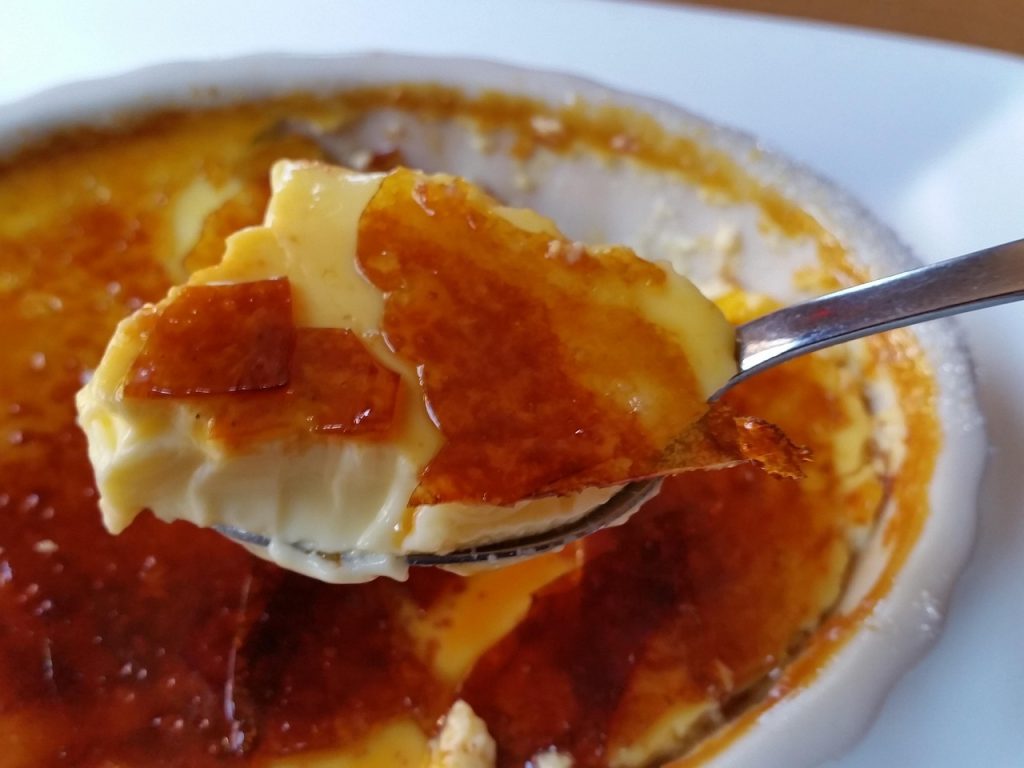Crème Brûlée is one of my absolute favorite desserts. The first spoonful of perfectly executed crème brûlée delivers an extraordinary sensory experience—the satisfying crack of caramelized sugar giving way to silky vanilla custard beneath. It’s so delicious to even think about.
Pairing wine with crème brûlée requires understanding both the dessert’s delicate custard base and its contrasting burnt sugar crown. The wrong wine choice can clash with the dessert’s sweetness, leaving your palate overwhelmed or underwhelmed. However, when done correctly, the right wine elevates both elements into a transcendent dining experience.
What are the Best Wines to Pair with Crème Brûlée?
Classic French crème brûlée consists of several distinct components that create unique wine pairing challenges. The silky custard base, made from heavy cream, egg yolks, sugar and vanilla bean, delivers rich fat content and subtle aromatics. As a result, the best wines to pair with crème brûlée can be a little more challenging than just red or white.
Sweet wines represent the most successful wine pairings with crème brûlée because they follow the fundamental principle that wine sweetness must match or exceed dessert sweetness. When wine is less sweet than the dessert, the contrast makes the wine taste unpleasantly sour or thin.
The acidity in sweet wines serves a crucial function—cutting through the custard’s richness while refreshing the palate between bites. This prevents flavor fatigue and allows both the wine and dessert to maintain their individual characteristics throughout the tasting experience.
Sauternes from Bordeaux
The gold standard crème brûlée wine pairing featuring honeyed sweetness balanced by crisp acidity that cuts through custard richness without overwhelming the delicate vanilla flavors. Noble rot concentration creates distinctive honeyed apricot and vanilla notes that mirror the dessert’s flavor profile while adding sophisticated complexity.
The wine’s bright acidity cuts through custard richness without overwhelming the delicate vanilla custard base. This balance allows each element to shine—the wine’s botrytis-derived flavors complement rather than compete with the caramelized sugar’s complexity.
Late Harvest Riesling
Aromatic stone fruit flavors beautifully complement the caramelized sugar while the natural acidity balances the sweetness and enhances the caramel notes through complementary fruit characteristics.
Moscato d’Asti
Gentle bubbles and natural sweetness enhance the dessert’s delicate textures without competing for attention. The wine’s light body and refreshing qualities make it perfect for ending rich meals. You might also opt for a glass of Champagne. While not as sweet, it still works.
Vin Santo
This Italian dessert wine is another perfect wine pairing for crème brûlée. Its flavors of hazelnut and caramel and smooth buttery texture are delicious completes to the custard and vanilla.
Easy Crème Brûlée Recipes
Wines to Avoid with Crème Brûlée
Understanding unsuccessful wine pairings helps prevent disappointing experiences and explains why certain combinations consistently fail to satisfy.
Dry wines create sourness when contrasted against dessert sweetness, making both the wine and dessert taste unpleasant. Sauvignon Blanc and Pinot Grigio, regardless of quality, simply cannot provide the sweetness necessary to complement crème brûlée’s rich profile.
Red wines present multiple problems—tannins clash with cream components and create metallic tastes that destroy both wine and dessert enjoyment. Young Bordeaux reds, Cabernet Sauvignon, and other tannic wines overwhelm delicate custard flavors while their dryness conflicts with caramelized sugar.
The perfect pairing transforms both wine and dessert into something greater than the sum of their parts. Whether you choose classic Sauternes for traditional elegance or explore creative alternatives like sparkling wine for modern appeal, understanding these fundamental principles ensures successful results every time.
Crème Brûlée Wine Paring FAQ
What’s the single best wine for classic crème brûlée? Sauternes remains the gold standard due to its perfect balance of honeyed sweetness, crisp acidity, and complementary vanilla flavors. The wine’s noble rot characteristics create complexity that enhances rather than competes with the dessert’s subtle elements.
Can I use California dessert wines instead of French options? Absolutely. California late harvest wines, particularly Riesling and Gewürztraminer styles, provide excellent alternatives to European dessert wines. Washington State also produces outstanding late harvest Riesling that pairs beautifully with crème brûlée at more accessible price points.
How sweet should the wine be compared to the dessert? The wine must be at least as sweet as the dessert to avoid unpleasant sourness. Ideally, wine sweetness should slightly exceed dessert sweetness, allowing the wine’s other characteristics—acidity, aromatics, complexity—to shine through without being overwhelmed.
What if I don’t like very sweet wines with dessert? Consider demi-sec sparkling wine or carefully selected fortified wines that provide richness without cloying sweetness. Vin Jaune represents another alternative, though it requires appreciation for oxidative wine styles and works best with vanilla-forward preparations.
Are there any budget-friendly pairing options under $30? Moscato d’Asti consistently delivers excellent value, often available for $15-25 while providing ideal sweetness and refreshing bubbles. Late harvest Riesling from Washington State and California also offers outstanding quality at accessible prices.
Elaine Schoch is an award-winning travel writer, wine judge, American Wine Specialist and certified by the Wine & Spirit Education Trust (WSET II). At Carpe Travel she shares wine travel destination guides for ALL WINE LOVERS – from novices to experienced pros – to help them plan their wine adventures, arming them with insider tips, must-visit spots, and things to see and do beyond the vines.


